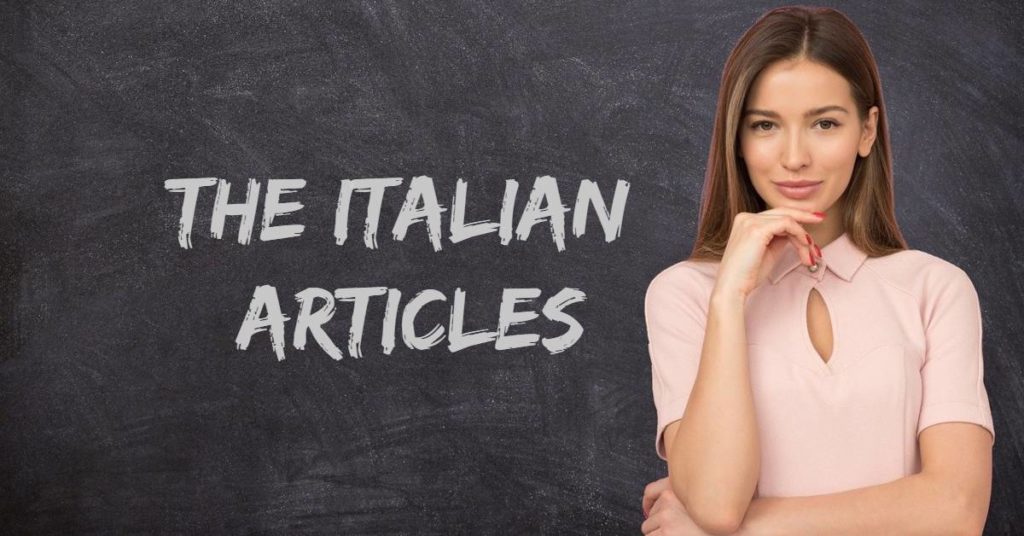What are the Italian articles as defined by the grammar rules? How do we distinguish definite articles from indefinite ones? Examples and differences will certainly help us to understand better, but let’s start from the beginning.
The word article comes from the Latin articulus, meaning “member,” or “limb,” and is an elementary unit in the system of grammatical forms; a minimum unit that expresses a meaning. The function of Italian articles is to specify some semantic characteristics of a given noun.
The articles specify the pragmatic opposition between the theme (what is known, given in the speech) and rema (what is new in the speech). Or the articles specify the pragmatic opposition between class and member.
In Italian, all nouns have a gender and a number. This means that everything has a gender, including objects and abstracts. The definite Italian articles must always match gender (masculine/feminine) and number (singular/plural) of the noun.
Articoli determinativi (definite Italian articles):
In English, we use “the” for all definite articles. In Italian, again, the article must match in gender and number with the subject.
Femine nouns are preceded by la (singular) or le (plural). If a singular noun begins with a consonant, then the “a” is dropped and the article is simply L’.
Masculine nouns have more variations, as explained in the section further below.
FEMMINILE
SINGOLARE: LA, (L’)
PLURALE: LE
MASCHILE
SINGOLARE: IL, LO, (L’)
PLURALE: I, GLI
“la” is the definite article that corresponds to feminine nouns.
- La casa the house.
- La scarpa the shoe.
“il”-“lo” are the definite articles that correspond to masculine nouns.
- Il professore the teacher.
- Il telefono the phone.
- Lo studente the student.
Why “il professore” but “lo studente?” Some masculine nouns use the article “lo” instead of “il.” Here are the rules to determine which article to use.
For singular nouns:
- LO: It is used for all masculine nouns beginning with s + consonant (st-, sp-, sc-, sv-), z, cluster gn, ps, or vowel.
- IL: It is used for all other masculine nouns starting with a consonant.
- LA: It is used with all feminine nouns.
- L’: This is the elision of “lo” or “la,” and it is used before masculine OR feminine nouns beginning with a vowel.
Examples:
- Lo zucchero » the sugar
- Il castello » the castle
- L’acqua » the water
- L’albero » the tree
For plural nouns the rules are the same:
- GLI: It is used with masculine nouns starting with vowels, the consonant z, cluster gn, ps, or clusters made of s + consonant.
- I: It is used with all the other masculine nouns which do not belong to the previous case.
- LE: It is used before any plural feminine noun.
Examples:
- Gli artisti » the artists
- I cavalli » the horses
- Le amiche » the friends (fem.)
- I ragazzi » the boys
- Gli stessi ragazzi » the same boys
Articoli indeterminativi (indeterminate Italian articles):
Masculine singular: UN or UNO = A or ONE
Feminine singular: UNA or UN’ = A or ONE
The Italian indefinite article is only used with singular nouns. It also corresponds to the number one. Here are some rules to understand how to use these articles:
UNO: It is used for masculine words beginning with z, s + consonant, gn, ps, BUT not vowel.
UN: It is used for all other masculine words, including those starting with a vowel.
UNA: It is used with any feminine nouns.
UN’: It is the elision of “una,” used when feminine nouns start with a vowel.
Examples:
Un treno e una bicicletta » a train and a bicycle
Uno stadio e un’automobile » a stadium and a car
Definite and Indefinite Italian Article
Exercises (Answers below)
Complete the following sentences choosing the appropriate article.
- _____ casa è di fronte al mare.
- il
- le
- la
- lo
- ___ albero è in fiore.
- il
- la
- lo
- l’
- ___ vestito di Maria è molto elegante.
- la
- lo
- le
- il
- _____ anatre nuotano nello stagno.
- la
- il
- le
- i
- Antonio mangia _______ spaghetti ogni giorno.
- i
- le
- gli
- la
- _______ bottiglia è vuota.
- i
- le
- gli
- la
- _______ aereo vola su Roma.
a) l’
b) le
c) gli
d) la
The correct answer is: 3, la
"The house is in front of the sea."
The correct answer is: 4, l'
"The tree is in bloom."
The correct answer is: 4, il
"Maria's dress is very elegant."
The correct answer is: 3, le
"The ducks are swimming in the pond."
The correct answer is: 3, gli
"Anthony eats spaghetti every day."
The correct answer is: 4, la
"The bottle is empty."
The correct answer is: a, l'
"The airplane files over Rome."

